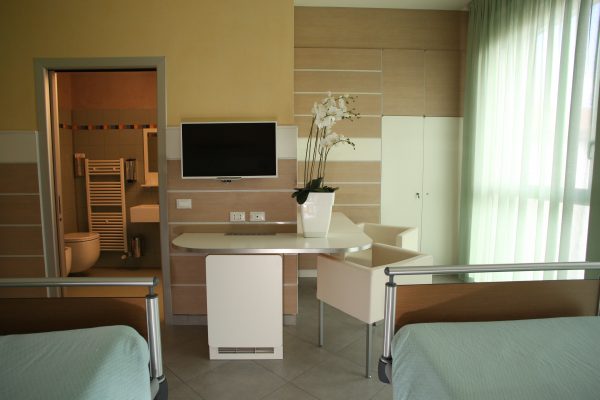Operazione all'anca
The hip joint is one of the major joints of the human body. The hip is the anatomical region that joins the trunk of the body, particularly the pelvic region, to the thigh and therefore to the lower limb. It is a joint that thanks to the ability of the femur to move 360 degrees within the acetabulum and to rotate around its axis approximately 90 degrees, it allows us to walk, run, jump and perform all everyday movements involving the legs.
More specifically, when talking about the “hip” we may be referring to the hip joint, also known as the coxofemoral joint, namely the joint between the cotyloid cavity of the iliac bone and the head of the femur. The joint surface of the cotyloid cavity (or acetabulum) consists of an incomplete C-shaped fibrocartilaginous ring. Its surface is smooth and covered with hyaline articular cartilage, which is thicker where the pressure of body weight when standing is greater (i.e. where its surface is broader). The head of the femur has a spherical shape at an early age (about 3/4 of a sphere), but with advancing age becomes more and more spherical and assumes a reverse curvature to the acetabulum, to which it is joined. Its bone surface is smooth and completely covered with hyaline articular cartilage, thicker at the centre than at the edges and in general where it sustains a greater load.
The full outer surface of the coxofemoral hip joint is covered in a thick and strong fibrous capsule. The coxofemoral joint is made up of five ligaments that affect its stability as a result of stretching and relaxation movements: ileofemoral, ischiofemoral, pubofemoral, head of the femur and transverse acetabular. A synovial sheath covers the entire internal surface of the coxofemoral joint cavity. Occasionally, the correct joint movement of our hips can become compromised in a more or less serious manner.
This can occur as a result of the natural aging process of the human body or as a result of injuries due to serious incidents (although sometimes even a simple fall or rheumatic, metabolic or congenital pathologies may have severe consequences). In less severe cases patients can resort to more conservative treatments (physiotherapy, shockwave therapy, thermal treatments, etc.) associated with drug therapies (FANS, infiltration of hyaluronic acid). However, as the hip is a joint that is subjected to continuous stress which can lead to its gradual wear and tear, hip surgery may be necessary.
When this impairment of the joint becomes more severe and is accompanied by chronic pain, as well as compromising normal walking activities, resulting in severe decline in the quality of life of the patient, hip prosthesis (replacement) surgery is recommended.
Hip dysplasia treatments
Hip dislocation (CHD) is a congenital disorder that manifests itself in children. Typically the hip, a spherical joint, fits firmly into the acetabular cup, thanks to the upper end of the femur. In children who are born with this kind of condition, the hip did not develop properly and is not attached correctly to the femur. In this case, a non-prosthetic conservative hip surgery may be necessary, if no benefit is obtained with the use of a brace or a harness.
Treatment of congenital hip dislocation
One of the most frequent pathologies in children, congenital hip dislocation in milder cases, is treated with a simple spreading pillow inserted inside nappies. In more severe cases, the treatment resorts to flexion using an abduction brace. Non-prosthetic conservative hip surgery occurs with a release of the adductor muscles, followed by traction of the limb to move it back to its own axis. The successive cast serves to keep the hip flexed and to limit adduction.
Treatment of hip osteoarthritis: primary and secondary (coxarthrosis)
In the presence of coxarthrosis of the hip, the femoral head cartilage tends to wear and causes the cavity of the femur not to join. In this case, the condition refers to early osteoarthritis of the hip, with chronic pain and difficulty in movement. If in addition to the cartilage, the wear extends to tissues, the osteoarthritis symptoms worsen and become secondary, exposing the underlying bone and causing the development of bony lumps known as osteophytes. This wear causes the muscles to weaken, necessitating a hip arthroplasty surgical intervention, which can be minimally invasive, with the replacement of the sick hip thanks to the use of metal, ceramic or plastic prosthetic implants.
Total hip prosthesis
In severe cases, a total hip prosthesis is implanted that replaces the damaged bone, the head of the femur and the acetabulum (the cartilage will also be removed and replaced with artificial implants). The procedure involves lateral incision and the insertion of the metal rod, “welded” with screws and cement, to improve the longevity of the metal prosthesis.
Hip arthroplasty revision surgery
With the application of hip prosthesis, the patient is advised to avoid sudden movements that can cause the dislocation of the hip on which surgery was performed. During the post-operative period, it is possible that the main components of the prosthesis become disconnected, where the prosthetic head comes out of the socket, due to a movement of the joint. It therefore becomes necessary to resort to hip arthroplasty revision surgery, in order to put the prosthesis back in place and to avoid bone damage.
Minimally invasive hip prosthesis: computer assisted prosthetic surgery
Computer assisted prosthetic surgery is a technique that takes advantage of a special navigator used in orthopaedics treatments that transmits real time information to the surgeon on how to operate, in order to achieve a high precision geometric reconstruction as part of the minimally invasive hip prosthesis insertion technique. This allows the placement of the prosthesis to be absolutely precise.

